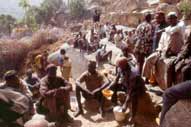Ethnographic Literature
This page gives a brief introduction into the history and trends of ethnographic literature dealing with the peoples of the Northern Mandaras, presented below under the headings Early Writings, Colonial Reports and Ethnographic Texts.
In order to identify the full bibliographical references mentioned please go to bibliography. To find literature dealing with particular ethnic groups, please click the group of your interest from the list of ethnic units. The list contains over fifty ethnic groups with references to their respective languages.
Early Writings
The earliest mentioning of peoples
of the northern Mandaras and its surrounding plains goes back to the
Italian monk Fra Mauro who produced a world map around 1450, in which
he placed the 'Mergi' (Margi) and 'Mandera' (Wandala) as well as some
names of places at their approximately correct geographical position.
The external sources of the sixteenth century are writings of Leo Africanus
(1526), Giovanni Lorenzo Anania (1573) and Ibn Furtu (1582). Main internal
source of the seventeenth and eighteenth century is the Kirgam-a-Wandala
or 'chronicles of Wandala' (Mohammadou 1982). The major nineteenth-century
European sources are Denham (1826) and Barth (1857).
Colonial Reports
The first topographical map of the
Northern Mandaras was produced by the German colonial geographer Moisel
(1912-13). Important German colonial reports have been written by Hauptmann
Zimmermann (1906), Oberleutnant Dominik (1908), Hauptmann Struempell (1910-1922)
and Hauptmann von Raben (1914-1916).
British and French colonial reports of particular ethnographic interest
are Mathews (1934), MacBride (1937), White (1944), Vaillant (1946), Mouchet
(1938-1955) and the annual reports of the British and French (see colonial
office) to the League of Nations and the United Nations (1927-1961). An
internal source is The Diary of Hamman Yaji (1912-1927).
Ethnographic Texts
The development of professional
ethnographic writing begins earlier on the Nigerian side of the mountains
than on the Cameroonian. A British governmental anthropologist surveyed
parts of the Nigerian mountains, whereas on the French side this was done
by administrators. During German colonial rule no anthropologist worked
in the Northern Mandaras.
Meek's 'Tribal Studies' (1931) is the first account on the Northern Mandaras
written by a professional ethnographer. Unfortunately, Meek did not include
the Gwoza Hills. However, French colonial administrators wrote well informed
ethnographic monographs, e.g. Lavergne (1944) about the Mafa/Matakam and
Lembezat (1952) about the Mukulehe clan of the Podokwa.
Hinderling (1954) was the first German anthropologist who wrote on the
Northern Mandaras. French professional anthropologists started their research
only after independence. They were later followed by Canadian and Dutch
ethnographers. There is also a tradition of indigenous ethnography (Ela).
Another ethnographic tradition is travel writing and film making (Gardi).
